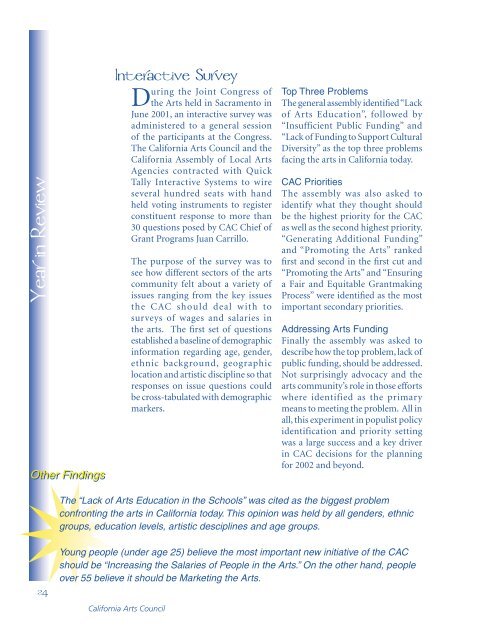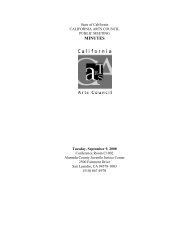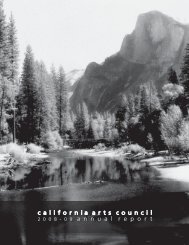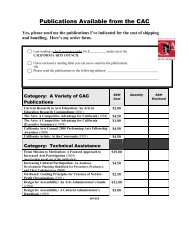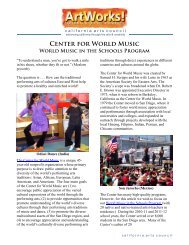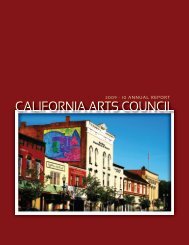2000-2001 - California Arts Council
2000-2001 - California Arts Council
2000-2001 - California Arts Council
Create successful ePaper yourself
Turn your PDF publications into a flip-book with our unique Google optimized e-Paper software.
24Year in Review<br />
Other Findings<br />
Interactive Survey<br />
During the Joint Congress of<br />
the <strong>Arts</strong> held in Sacramento in<br />
June <strong>2001</strong>, an interactive survey was<br />
administered to a general session<br />
of the participants at the Congress.<br />
The <strong>California</strong> <strong>Arts</strong> <strong>Council</strong> and the<br />
<strong>California</strong> Assembly of Local <strong>Arts</strong><br />
Agencies contracted with Quick<br />
Tally Interactive Systems to wire<br />
several hundred seats with hand<br />
held voting instruments to register<br />
constituent response to more than<br />
30 questions posed by CAC Chief of<br />
Grant Programs Juan Carrillo.<br />
The purpose of the survey was to<br />
see how different sectors of the arts<br />
community felt about a variety of<br />
issues ranging from the key issues<br />
the CAC should deal with to<br />
surveys of wages and salaries in<br />
the arts. The first set of questions<br />
established a baseline of demographic<br />
information regarding age, gender,<br />
ethnic background, geographic<br />
location and artistic discipline so that<br />
responses on issue questions could<br />
be cross-tabulated with demographic<br />
markers.<br />
Top Three Problems<br />
The general assembly identified “Lack<br />
of <strong>Arts</strong> Education”, followed by<br />
“Insufficient Public Funding” and<br />
“Lack of Funding to Support Cultural<br />
Diversity” as the top three problems<br />
facing the arts in <strong>California</strong> today.<br />
CAC Priorities<br />
The assembly was also asked to<br />
identify what they thought should<br />
be the highest priority for the CAC<br />
as well as the second highest priority.<br />
“Generating Additional Funding”<br />
and “Promoting the <strong>Arts</strong>” ranked<br />
first and second in the first cut and<br />
“Promoting the <strong>Arts</strong>” and “Ensuring<br />
a Fair and Equitable Grantmaking<br />
Process” were identified as the most<br />
important secondary priorities.<br />
Addressing <strong>Arts</strong> Funding<br />
Finally the assembly was asked to<br />
describe how the top problem, lack of<br />
public funding, should be addressed.<br />
Not surprisingly advocacy and the<br />
arts community’s role in those efforts<br />
where identified as the primary<br />
means to meeting the problem. All in<br />
all, this experiment in populist policy<br />
identification and priority setting<br />
was a large success and a key driver<br />
in CAC decisions for the planning<br />
for 2002 and beyond.<br />
The “Lack of <strong>Arts</strong> Education in the Schools” was cited as the biggest problem<br />
confronting the arts in <strong>California</strong> today. This opinion was held by all genders, ethnic<br />
groups, education levels, artistic desciplines and age groups.<br />
Young people (under age 25) believe the most important new initiative of the CAC<br />
should be “Increasing the Salaries of People in the <strong>Arts</strong>.” On the other hand, people<br />
over 55 believe it should be Marketing the <strong>Arts</strong>.<br />
<strong>California</strong> <strong>Arts</strong> <strong>Council</strong>


